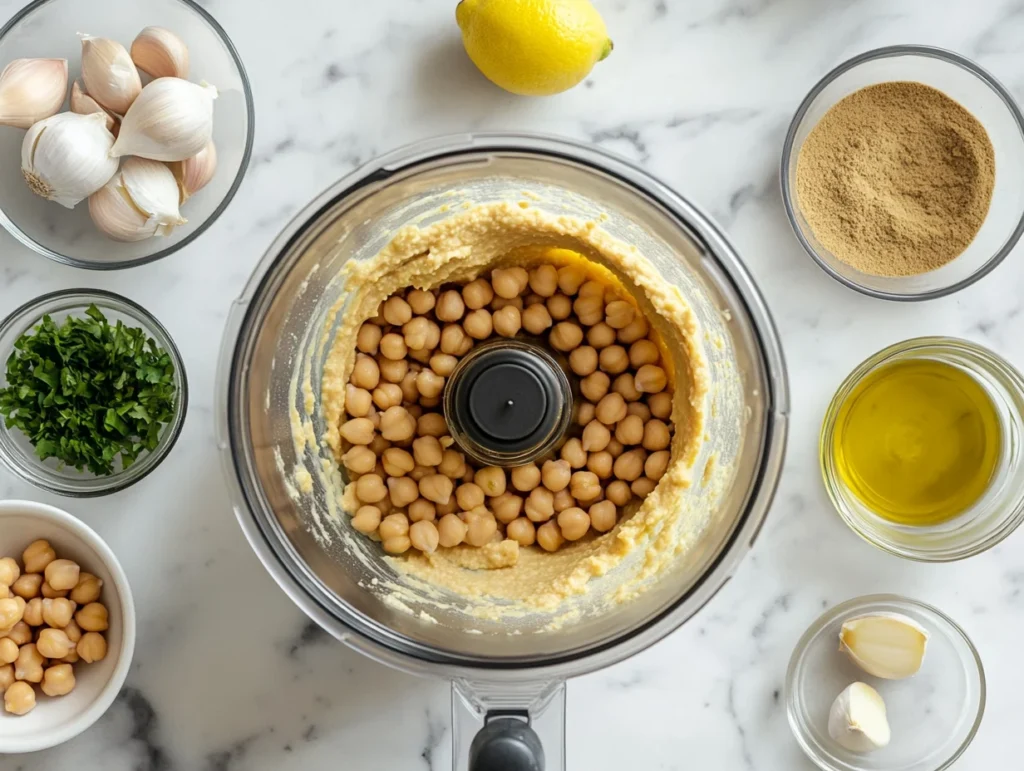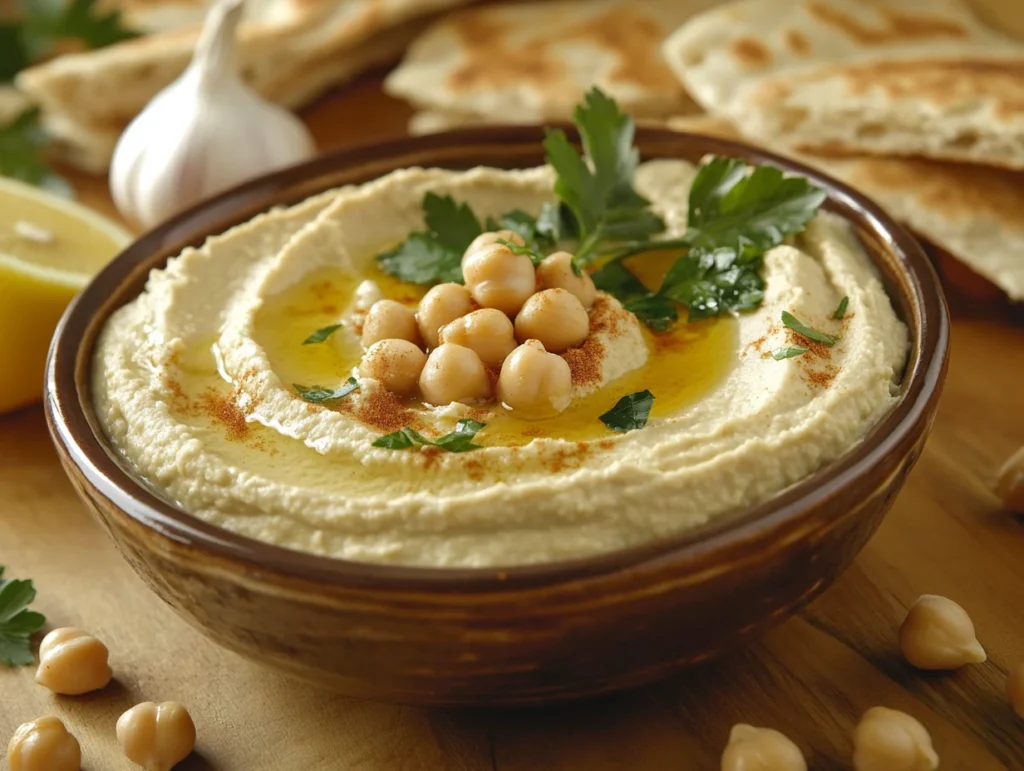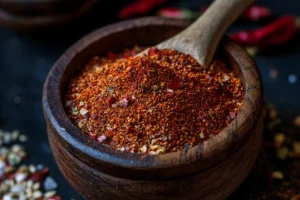Hummus, a creamy, protein-packed dip, has become a global favorite. Traditionally made with tahini—a sesame seed paste—it carries a distinct nutty flavor. But what if you don’t have tahini at home or want a simpler, more budget-friendly version? Enter homemade garlic hummus without tahini! This guide explores how you can create a rich, smooth, and flavorful hummus without using tahini while maintaining that classic taste everyone loves.
We’ll cover everything from understanding the essential ingredients and step-by-step preparation to answering common questions and sharing tips for perfecting your recipe. Whether you’re a seasoned chef or a beginner in the kitchen, this article is your one-stop resource for mastering homemade garlic hummus without tahini. Let’s dive in!
Introduction
Why Make Hummus Without Tahini?
Tahini is a staple in traditional hummus recipes, but it’s not always accessible or budget-friendly. Plus, not everyone loves its earthy, slightly bitter flavor. If you’re someone who prefers to keep things simple, homemade garlic hummus without tahini is the perfect alternative.
Skipping tahini doesn’t mean sacrificing taste or texture. With just a few common pantry staples—like chickpeas, olive oil, lemon juice, and garlic—you can whip up a creamy, protein-rich dip in no time. Another advantage? You have complete control over the flavor profile, making it tangier, spicier, or milder according to your preference.
For those with sesame allergies, this recipe is a lifesaver. And let’s face it, not everyone has tahini lying around in their kitchen! But chickpeas, olive oil, and garlic? Almost every household stocks those.
Understanding the Key Ingredients for Garlic Hummus Without Tahini
When crafting the perfect chickpea dip without tahini, the key lies in balancing flavors and textures. Here are the essential ingredients:
- Chickpeas (Garbanzo Beans): These little legumes form the creamy, protein-rich base of hummus. Canned chickpeas are the easiest option, but freshly cooked chickpeas can add an extra layer of creaminess.
- Garlic: Fresh garlic is non-negotiable in creamy garlic hummus recipes. It adds a bold, aromatic kick.
- Olive Oil: The golden elixir! Olive oil adds richness and silkiness to the hummus.
- Lemon Juice: Fresh lemon juice brightens up the dip with its zesty tang.
- Cumin: A warm, earthy spice that ties all the flavors together beautifully.
These simple ingredients, when combined, create a rich, smooth, and flavorful hummus without the need for tahini.
Cost and Availability of Tahini vs. Alternative Recipes
Let’s be honest: tahini isn’t always easy to find, and when you do spot it on the shelf, it’s often expensive. A jar of tahini can cost as much as several cans of chickpeas, making it a luxury ingredient for some households.
By choosing to make homemade garlic hummus without tahini, you’re opting for an affordable and equally delicious alternative. All the key ingredients—chickpeas, olive oil, garlic, and lemon—are widely available and inexpensive. Plus, this recipe avoids any complicated steps or hard-to-find ingredients.
Another bonus? You’re reducing food waste. With simple pantry staples, you can whip up a fresh batch of hummus whenever you like, without worrying about tahini sitting unused in your fridge.
Ingredients for Homemade Garlic Hummus Without Tahini
Essential Ingredients for Creamy Garlic Hummus
The beauty of homemade garlic hummus without tahini lies in its simplicity. Each ingredient plays a crucial role in creating the perfect balance of flavor and texture. Let’s break them down:
- Chickpeas (Garbanzo Beans): The foundation of any hummus recipe. Opt for canned chickpeas for convenience, but if using dried chickpeas, ensure they are fully cooked for a creamy texture.
- Garlic: Fresh garlic adds an aromatic punch, but roasted garlic can give your hummus a sweeter and milder profile.
- Olive Oil: Adds richness and helps blend the hummus smoothly. Extra virgin olive oil is the best choice for its robust flavor.
- Lemon Juice: The bright acidity of lemon juice balances the richness of the chickpeas and olive oil.
- Cumin: This earthy spice enhances the depth of flavor in homemade garlic hummus without tahini.
- Water: Adjust the consistency of your hummus by adding water gradually during blending.
- Salt: A small pinch ties all the flavors together perfectly.
Ingredient Substitutes for Tahini-Free Hummus
While tahini is traditionally used for its nutty taste, homemade garlic hummus without tahini remains delicious with these easy substitutes:
- Greek Yogurt: Adds creaminess and a slight tang.
- Peanut Butter: Offers a similar texture and richness.
- Sesame Oil: A few drops can mimic tahini’s nutty flavor.
Each substitute brings its unique twist to the recipe, allowing you to customize your hummus based on what you have available.
For more inspiration, check out this related chickpea hummus recipe without tahini.
Step-by-Step Guide to Making Garlic Hummus Without Tahini

Preparing Your Chickpeas for Maximum Creaminess
To achieve the smoothest texture for your homemade garlic hummus without tahini, proper preparation is key. If using canned chickpeas:
- Rinse them thoroughly to reduce sodium content.
- For an extra smooth texture, peel the chickpeas. While this step is optional, it makes a significant difference.
If using dried chickpeas:
- Soak them overnight in water.
- Cook until soft, ideally with a pinch of baking soda to break down the skins.
These simple steps set the stage for creamy, restaurant-quality hummus.
Blending Techniques for Smooth Hummus Texture
Follow these steps to prepare your hummus:
- Add chickpeas, minced garlic, olive oil, lemon juice, cumin, and a pinch of salt into a food processor.
- Blend on high for 1-2 minutes. Pause occasionally to scrape down the sides.
- Gradually add water, one tablespoon at a time, until the hummus reaches your desired consistency.
- Taste and adjust seasoning as needed—add more lemon juice for tanginess or cumin for warmth.
For an ultra-smooth texture, let the food processor run an extra minute longer.
Balancing Flavors: Garlic, Lemon, and Cumin
Flavor is where homemade garlic hummus without tahini truly shines. Garlic adds a punch, lemon juice brightens the taste, and cumin grounds everything with earthy warmth. Adjust each element to suit your preference:
- Prefer a bolder garlic taste? Add an extra clove.
- Craving tanginess? A splash more lemon juice will do the trick.
- Need warmth? A dash of cumin ties it all together.
Experiment and trust your taste buds to guide you.
For more creative uses of garlic-infused recipes, check out this roasted garlic tuna salad.
Tips for Achieving Creamy and Flavorful Hummus Without Tahini
Common Mistakes and How to Avoid Them
Making homemade garlic hummus without tahini might seem straightforward, but small missteps can lead to grainy or overly thick hummus. One common mistake is not blending the chickpeas long enough. For the creamiest texture, let your food processor run for at least 2-3 minutes. Another error is skipping the peeling step for chickpeas. While peeling might seem tedious, it can drastically improve the smoothness of your hummus.
Additionally, be mindful of how much water you add. Adding too little water can make the hummus stiff, while too much will leave it runny. Start small and adjust gradually. Lastly, don’t skimp on olive oil. It’s not just for flavor but also for achieving a luxurious texture.
How to Adjust Consistency and Flavor
The beauty of homemade garlic hummus without tahini is how customizable it is. If your hummus feels too thick, add a tablespoon of water or olive oil at a time until it reaches the desired consistency. For extra creaminess, some people even add a spoonful of Greek yogurt.
When it comes to flavor, balance is key. Taste as you go and tweak the garlic, lemon, or cumin to suit your preferences. Want it spicier? Add a pinch of cayenne pepper. Prefer more tanginess? A splash of lemon juice does wonders.
Storage Tips for Freshness
Freshly made hummus can last in the refrigerator for up to five days. Store it in an airtight container and drizzle a thin layer of olive oil on top to keep it moist. If you notice any off smell or taste, it’s time to toss it out.
For more delicious recipes and cooking tips, check out this creamy potato soup recipe.
Serving Suggestions for Garlic Hummus Without Tahini
Ideal Pairings: Vegetables, Bread, and Crackers
One of the joys of homemade garlic hummus without tahini is its versatility. It pairs beautifully with crisp veggies like carrot sticks, cucumber slices, bell peppers, and celery. For a heartier snack, serve it with warm pita bread, naan, or crunchy tortilla chips.
If you’re hosting a party, create a mezze platter with olives, falafel, pickles, and hummus as the centerpiece. It’s guaranteed to impress your guests!
Creative Uses for Hummus in Recipes
Hummus isn’t just for dipping—it’s also an excellent ingredient in other dishes. Use it as a sandwich spread instead of mayonnaise, or as a base for a Mediterranean pizza. It’s also great as a sauce for pasta, providing a creamy, dairy-free alternative.
Presentation Tips for Serving Hummus at Gatherings
A well-presented bowl of hummus can elevate your dining experience. Spoon your hummus into a shallow bowl, drizzle it generously with olive oil, sprinkle some paprika or cumin on top, and garnish with fresh parsley.
Serve it alongside a variety of dippers for visual appeal and flavor variety. With these simple tips, your homemade garlic hummus without tahini will be both delicious and picture-perfect!
Nutritional Benefits of Garlic Hummus Without Tahini
Health Benefits of Chickpeas
Chickpeas, the main ingredient in homemade garlic hummus without tahini, are little nutritional powerhouses. They are rich in protein, fiber, and essential vitamins like folate and iron. These nutrients not only support digestion but also keep you feeling full for longer periods. Chickpeas are also an excellent plant-based protein source, making this hummus a fantastic option for vegetarians and vegans.
In addition to protein and fiber, chickpeas are packed with antioxidants, which help fight inflammation and reduce the risk of chronic diseases.
Nutritional Comparison: With and Without Tahini
While traditional hummus with tahini adds extra healthy fats and calcium from sesame seeds, homemade garlic hummus without tahini remains a lighter and lower-calorie option. By skipping tahini, you reduce the overall fat content while keeping the dish protein-rich and satisfying.
If you’re watching your calorie intake but still crave a flavorful and creamy snack, this tahini-free hummus strikes the perfect balance between taste and nutrition.
Why Garlic Is a Superfood Ingredient
Garlic isn’t just a flavor booster—it’s also incredibly nutritious. Known for its immune-boosting properties, garlic contains compounds like allicin, which have anti-inflammatory and antimicrobial effects.
When combined with protein-packed chickpeas, fresh lemon juice, and heart-healthy olive oil, garlic transforms homemade garlic hummus without tahini into a nutrient-dense, guilt-free snack.
Variations of Garlic Hummus Without Tahini
Spicy Garlic Hummus
If you love bold flavors, a spicy twist on homemade garlic hummus without tahini might just become your favorite version. Add a pinch of cayenne pepper, red pepper flakes, or even a drizzle of chili oil to your hummus. The result? A dip with a fiery kick that pairs perfectly with crunchy veggies or pita chips.
Lemon and Herb Infused Hummus
For a fresh and zesty variation, try adding extra lemon juice, zest, and a handful of fresh herbs like parsley, cilantro, or dill. This version of homemade garlic hummus without tahini is bright, tangy, and packed with flavor—perfect for summer picnics or light appetizers.
Roasted Garlic Hummus Recipe
Want an extra depth of flavor? Roast your garlic cloves before blending them into the hummus. Roasted garlic mellows out and develops a sweet, caramelized taste that adds richness to your dip. Simply wrap a head of garlic in foil, drizzle with olive oil, and roast it in the oven until soft and golden.
These variations prove that homemade garlic hummus without tahini can be easily customized to suit your taste preferences, making it a versatile dish for any occasion.
Frequently Asked Questions
What Can I Use Instead of Tahini in Hummus?
If you’re making homemade garlic hummus without tahini, you have several excellent substitutes. Olive oil, Greek yogurt, or even a spoonful of peanut butter can add creaminess and richness to your hummus. If you’re looking for a nut-free option, a splash of extra lemon juice or a dollop of plain yogurt works wonders in balancing flavor and texture.
What Is Traditional Hummus Made of Without Tahini?
Traditional hummus includes chickpeas, garlic, olive oil, lemon juice, and tahini. But when making homemade garlic hummus without tahini, you simply skip the tahini and focus on balancing the flavors with olive oil, lemon juice, and garlic. The result is a lighter yet equally creamy hummus that’s just as flavorful.
Why Is My Homemade Hummus Not Creamy?
Achieving a creamy texture in homemade garlic hummus without tahini depends on a few factors. First, ensure your chickpeas are soft—canned chickpeas work great. Second, blend your ingredients long enough in a food processor. Lastly, don’t shy away from adding olive oil and water gradually to smooth out the mixture.
What Is Garlic Hummus Made of?
Garlic hummus primarily includes chickpeas, fresh garlic, olive oil, lemon juice, and seasonings like cumin and salt. These simple ingredients come together to create a deliciously smooth and flavorful dip.
If you still have more questions, don’t hesitate to experiment and adjust your recipe to suit your taste.
Final Thoughts and Recipe Recap
Why Homemade Garlic Hummus Without Tahini Is Worth Trying
Making homemade garlic hummus without tahini is not only cost-effective but also incredibly easy. You’ll love how customizable this recipe is, from flavor variations to consistency adjustments. Plus, it’s a healthier alternative to store-bought options, free from preservatives and additives.
Quick Summary of Key Steps and Tips
- Use canned chickpeas for convenience.
- Blend thoroughly for a smooth texture.
- Adjust water and olive oil gradually.
- Experiment with variations like roasted garlic or spicy hummus.




1 thought on “The Ultimate Guide to Homemade Garlic Hummus Without Tahini”